TOYOTA RAV4 HYBRID 2020 Warranties & Maintenance Guides (in English)
Manufacturer: TOYOTA, Model Year: 2020, Model line: RAV4 HYBRID, Model: TOYOTA RAV4 HYBRID 2020Pages: 260, PDF Size: 8.54 MB
Page 121 of 260
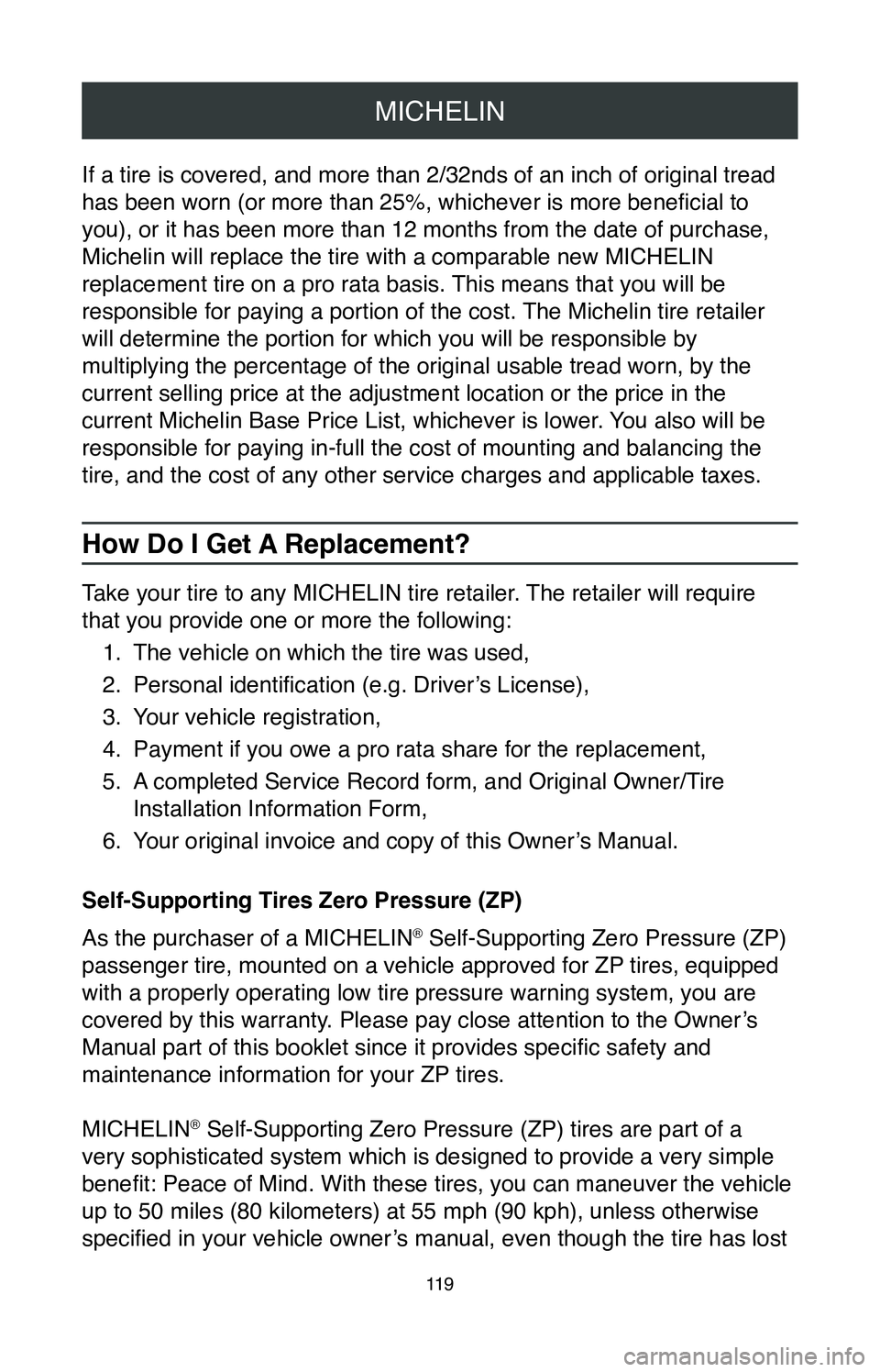
MICHELIN
11 9
If a tire is covered, and more than 2/32nds of an inch of original tread\
has been worn (or more than 25%, whichever is more beneficial to
you), or it has been more than 12 months from the date of purchase,
Michelin will replace the tire with a comparable new MICHELIN
replacement tire on a pro rata basis. This means that you will be
responsible for paying a portion of the cost. The Michelin tire retailer
will determine the portion for which you will be responsible by
multiplying the percentage of the original usable tread worn, by the
current selling price at the adjustment location or the price in the
current Michelin Base Price List, whichever is lower. You also will be
responsible for paying in-full the cost of mounting and balancing the
tire, and the cost of any other service charges and applicable taxes.
How Do I Get A Replacement?
Take your tire to any MICHELIN tire retailer. The retailer will require
that you provide one or more the following:1.
The vehicle on which the tire was used,
2.
Personal identification (e.g. Driver’s License),
3.
Your vehicle registration,
4.
Payment if you owe a pro rata share for the replacement,
5.
A completed Service Record form, and Original Owner/Tire
Installation Information Form,
6.
Your original invoice and copy of this Owner’s Manual.
Self-Supporting Tires Zero Pressure (ZP)
As the purchaser of a MICHELIN
® Self-Supporting Zero Pressure (ZP)
passenger tire, mounted on a vehicle approved for ZP tires, equipped
with a properly operating low tire pressure warning system, you are
covered by this warranty. Please pay close attention to the Owner’s
Manual part of this booklet since it provides specific safety and
maintenance information for your ZP tires.
MICHELIN
® Self-Supporting Zero Pressure (ZP) tires are part of a
very sophisticated system which is designed to provide a very simple
benefit: Peace of Mind. With these tires, you can maneuver the vehicle
up to 50 miles (80 kilometers) at 55 mph (90 kph), unless otherwise
specified in your vehicle owner’s manual, even though the tire has lost
Page 122 of 260
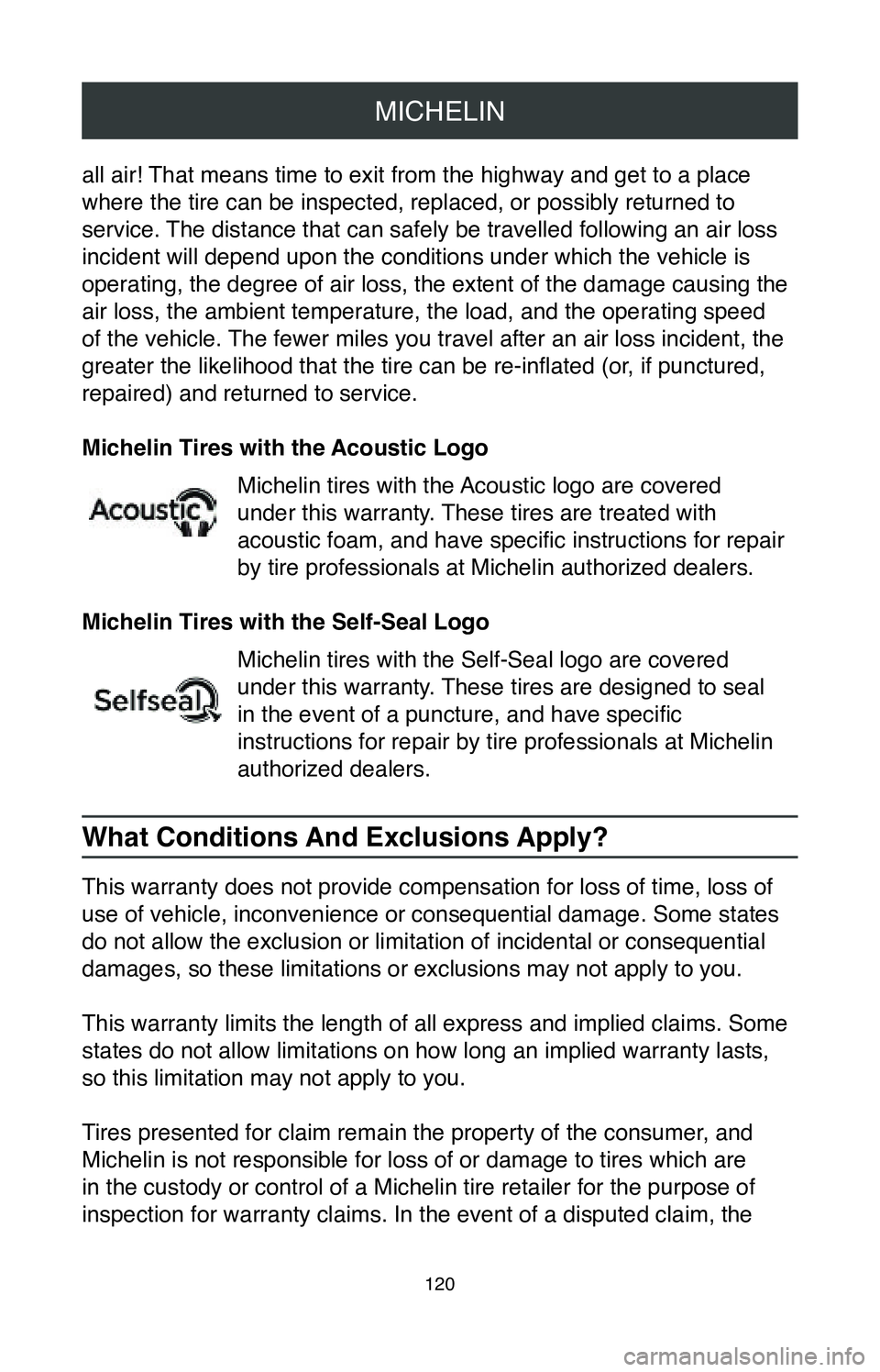
MICHELIN
120
all air! That means time to exit from the highway and get to a place
where the tire can be inspected, replaced, or possibly returned to
service. The distance that can safely be travelled following an air loss
incident will depend upon the conditions under which the vehicle is
operating, the degree of air loss, the extent of the damage causing the \
air loss, the ambient temperature, the load, and the operating speed
of the vehicle. The fewer miles you travel after an air loss incident, the
greater the likelihood that the tire can be re-inflated (or, if punctured,
repaired) and returned to service.
Michelin Tires with the Acoustic Logo Michelin tires with the Acoustic logo are covered
under this warranty. These tires are treated with
acoustic foam, and have specific instructions for repair
by tire professionals at Michelin authorized dealers.
Michelin Tires with the Self-Seal Logo
Michelin tires with the Self-Seal logo are covered
under this warranty. These tires are designed to seal
in the event of a puncture, and have specific
instructions for repair by tire professionals at Michelin
authorized dealers.
What Conditions And Exclusions Apply?
This warranty does not provide compensation for loss of time, loss of
use of vehicle, inconvenience or consequential damage. Some states
do not allow the exclusion or limitation of incidental or consequential \
damages, so these limitations or exclusions may not apply to you.
This warranty limits the length of all express and implied claims. Some \
states do not allow limitations on how long an implied warranty lasts,
so this limitation may not apply to you.
Tires presented for claim remain the property of the consumer, and
Michelin is not responsible for loss of or damage to tires which are
in the custody or control of a Michelin tire retailer for the purpose of\
inspection for warranty claims. In the event of a disputed claim, the
Page 123 of 260
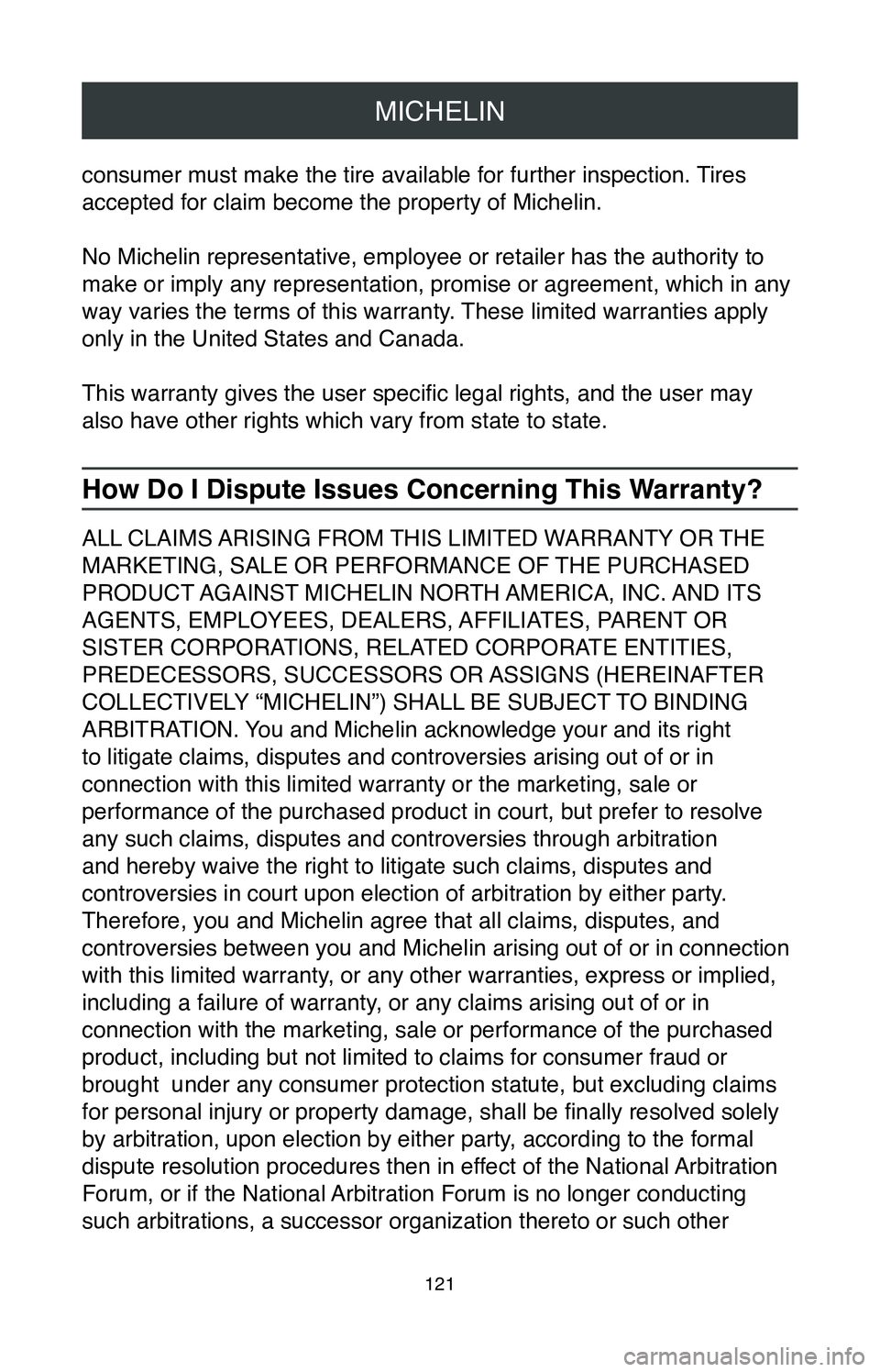
MICHELIN
121
consumer must make the tire available for further inspection. Tires
accepted for claim become the property of Michelin.
No Michelin representative, employee or retailer has the authority to
make or imply any representation, promise or agreement, which in any
way varies the terms of this warranty. These limited warranties apply
only in the United States and Canada.
This warranty gives the user specific legal rights, and the user may
also have other rights which vary from state to state.
How Do I Dispute Issues Concerning This Warranty?
ALL CLAIMS ARISING FROM THIS LIMITED WARRANTY OR THE
MARKETING, SALE OR PERFORMANCE OF THE PURCHASED
PRODUCT AGAINST MICHELIN NORTH AMERICA, INC. AND ITS
AGENTS, EMPLOYEES, DEALERS, AFFILIATES, PARENT OR
SISTER CORPORATIONS, RELATED CORPORATE ENTITIES,
PREDECESSORS, SUCCESSORS OR ASSIGNS (HEREINAFTER
COLLECTIVELY “MICHELIN”) SHALL BE SUBJECT TO BINDING
ARBITRATION. You and Michelin acknowledge your and its right
to litigate claims, disputes and controversies arising out of or in
connection with this limited warranty or the marketing, sale or
performance of the purchased product in court, but prefer to resolve
any such claims, disputes and controversies through arbitration
and hereby waive the right to litigate such claims, disputes and
controversies in court upon election of arbitration by either party.
Therefore, you and Michelin agree that all claims, disputes, and
controversies between you and Michelin arising out of or in connection
with this limited warranty, or any other warranties, express or implied,
including a failure of warranty, or any claims arising out of or in
connection with the marketing, sale or performance of the purchased
product, including but not limited to claims for consumer fraud or
brought under any consumer protection statute, but excluding claims
for personal injury or property damage, shall be finally resolved solely
by arbitration, upon election by either party, according to the formal
dispute resolution procedures then in effect of the National Arbitration
Forum, or if the National Arbitration Forum is no longer conducting
such arbitrations, a successor organization thereto or such other
Page 124 of 260
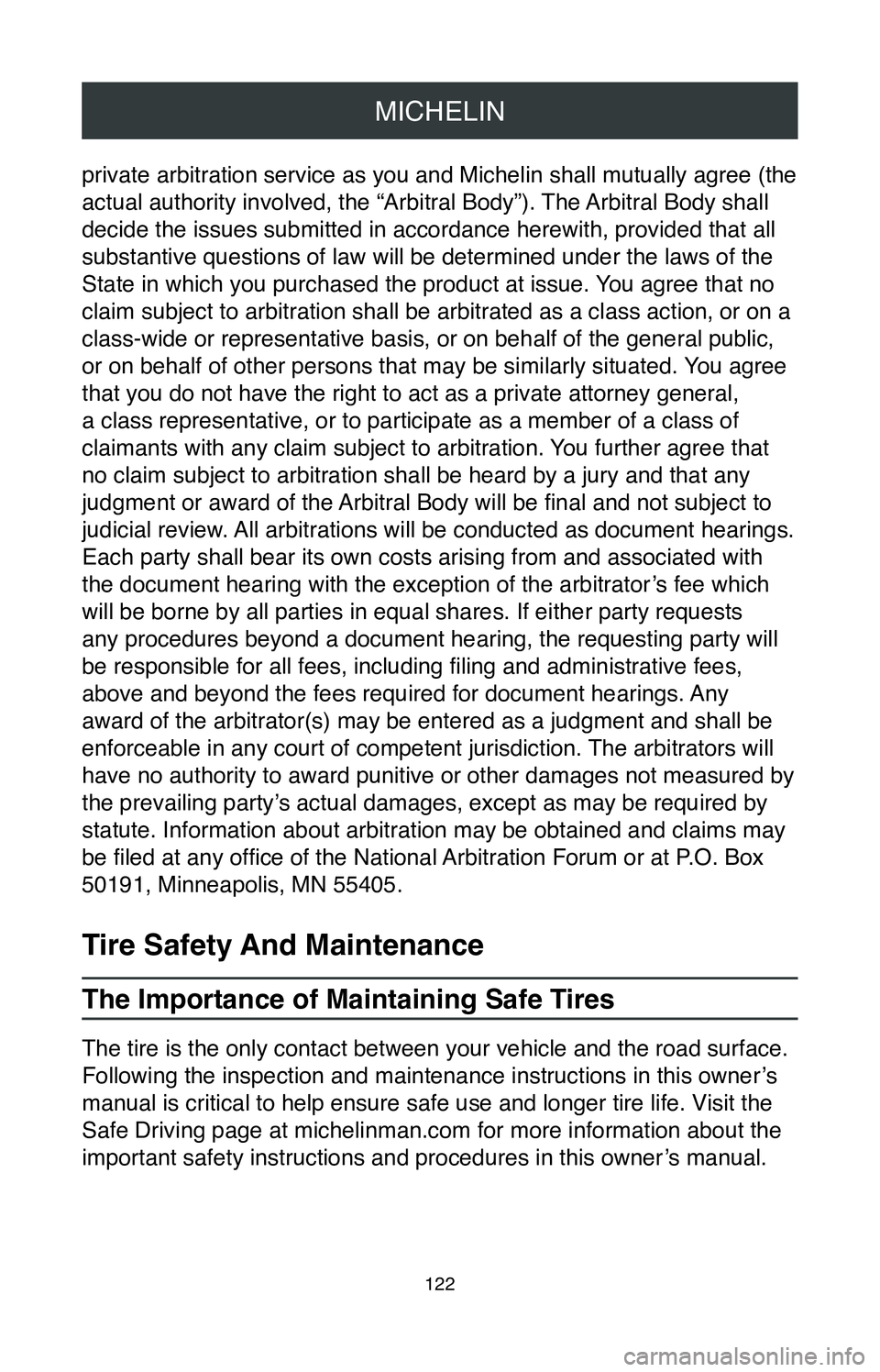
MICHELIN
122
private arbitration service as you and Michelin shall mutually agree (the
actual authority involved, the “Arbitral Body”). The Arbitral Body shall
decide the issues submitted in accordance herewith, provided that all
substantive questions of law will be determined under the laws of the
State in which you purchased the product at issue. You agree that no
claim subject to arbitration shall be arbitrated as a class action, or on a
class-wide or representative basis, or on behalf of the general public,
or on behalf of other persons that may be similarly situated. You agree
that you do not have the right to act as a private attorney general,
a class representative, or to participate as a member of a class of
claimants with any claim subject to arbitration. You further agree that
no claim subject to arbitration shall be heard by a jury and that any
judgment or award of the Arbitral Body will be final and not subject to
judicial review. All arbitrations will be conducted as document hearings.
Each party shall bear its own costs arising from and associated with
the document hearing with the exception of the arbitrator’s fee which
will be borne by all parties in equal shares. If either party requests
any procedures beyond a document hearing, the requesting party will
be responsible for all fees, including filing and administrative fees,
above and beyond the fees required for document hearings. Any
award of the arbitrator(s) may be entered as a judgment and shall be
enforceable in any court of competent jurisdiction. The arbitrators will
have no authority to award punitive or other damages not measured by
the prevailing party’s actual damages, except as may be required by
statute. Information about arbitration may be obtained and claims may
be filed at any office of the National Arbitration Forum or at P.O. Box
50191, Minneapolis, MN 55405.
Tire Safety And Maintenance
The Importance of Maintaining Safe Tires
The tire is the only contact between your vehicle and the road surface. \
Following the inspection and maintenance instructions in this owner’s
manual is critical to help ensure safe use and longer tire life. Visit the
Safe Driving page at michelinman.com for more information about the
important safety instructions and procedures in this owner’s manual.
Page 125 of 260
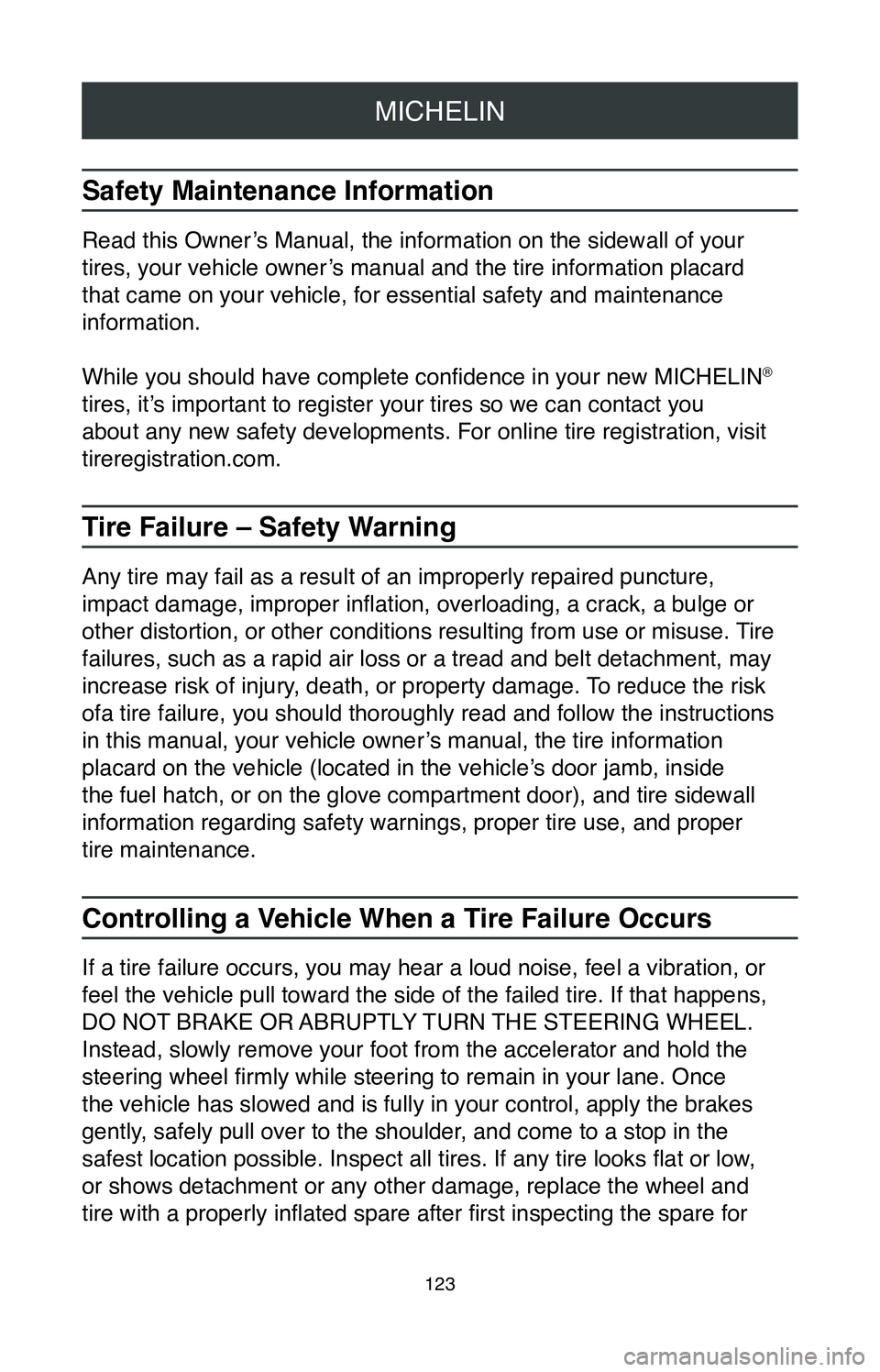
MICHELIN
123
Safety Maintenance Information
Read this Owner’s Manual, the information on the sidewall of your
tires, your vehicle owner’s manual and the tire information placard
that came on your vehicle, for essential safety and maintenance
information.
While you should have complete confidence in your new MICHELIN
®
tires, it’s important to register your tires so we can contact you
about any new safety developments. For online tire registration, visit
tireregistration.com.
Tire Failure – Safety Warning
Any tire may fail as a result of an improperly repaired puncture,
impact damage, improper inflation, overloading, a crack, a bulge or
other distortion, or other conditions resulting from use or misuse. Tire
failures, such as a rapid air loss or a tread and belt detachment, may
increase risk of injury, death, or property damage. To reduce the risk
ofa tire failure, you should thoroughly read and follow the instructions\
in this manual, your vehicle owner’s manual, the tire information
placard on the vehicle (located in the vehicle’s door jamb, inside
the fuel hatch, or on the glove compartment door), and tire sidewall
information regarding safety warnings, proper tire use, and proper
tire maintenance.
Controlling a Vehicle When a Tire Failure Occurs
If a tire failure occurs, you may hear a loud noise, feel a vibration, o\
r
feel the vehicle pull toward the side of the failed tire. If that happen\
s,
DO NOT BRAKE OR ABRUPTLY TURN THE STEERING WHEEL.
Instead, slowly remove your foot from the accelerator and hold the
steering wheel firmly while steering to remain in your lane. Once
the vehicle has slowed and is fully in your control, apply the brakes
gently, safely pull over to the shoulder, and come to a stop in the
safest location possible. Inspect all tires. If any tire looks flat or low ,
or shows detachment or any other damage, replace the wheel and
tire with a properly inflated spare after first inspecting the spare for
Page 126 of 260
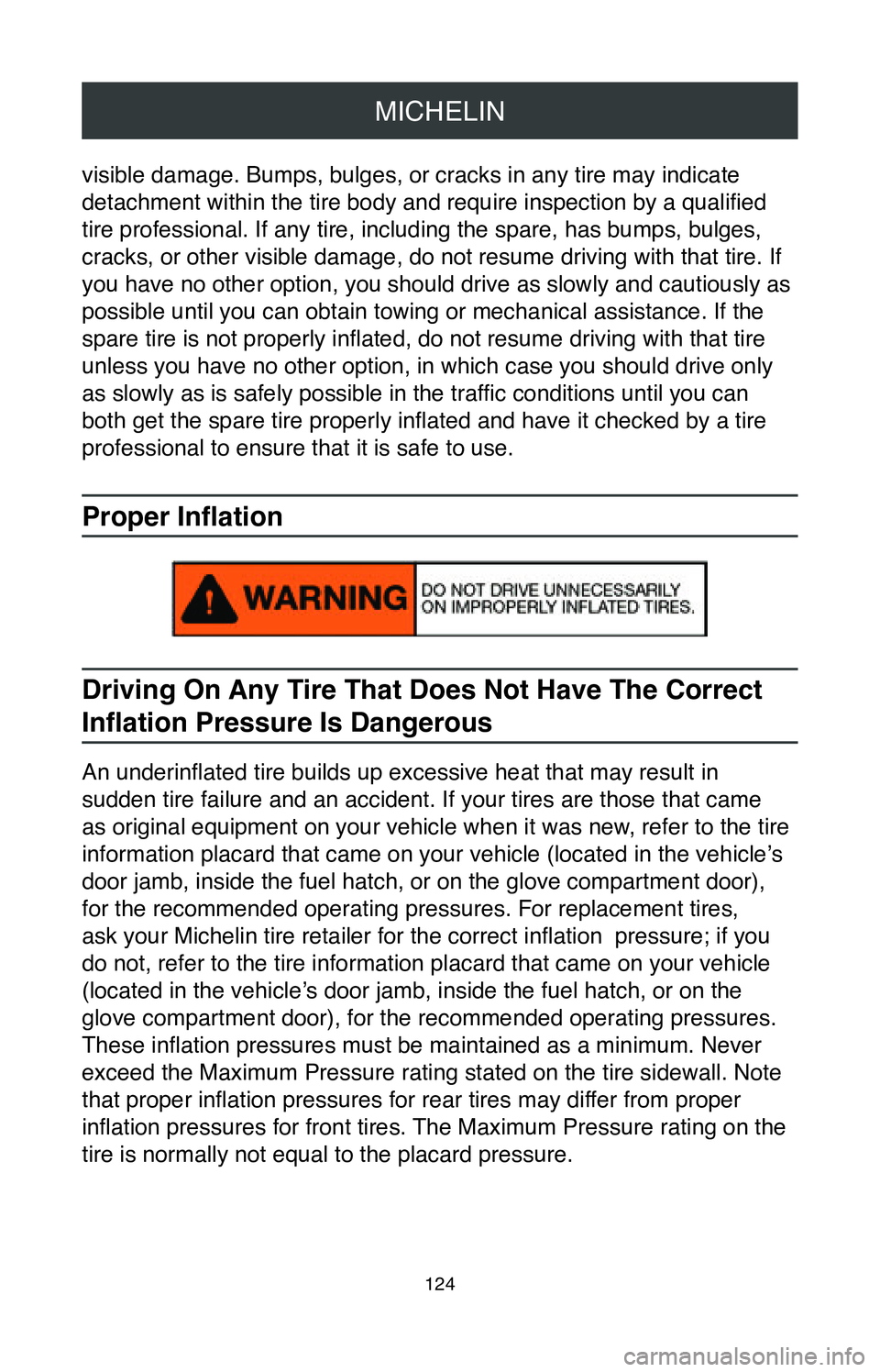
MICHELIN
124
visible damage. Bumps, bulges, or cracks in any tire may indicate
detachment within the tire body and require inspection by a qualified
tire professional. If any tire, including the spare, has bumps, bulges, \
cracks, or other visible damage, do not resume driving with that tire. I\
f
you have no other option, you should drive as slowly and cautiously as
possible until you can obtain towing or mechanical assistance. If the
spare tire is not properly inflated, do not resume driving with that tire
unless you have no other option, in which case you should drive only
as slowly as is safely possible in the traffic conditions until you can
both get the spare tire properly inflated and have it checked by a tire
professional to ensure that it is safe to use.
Proper Inflation
Driving On Any Tire That Does Not Have The Correct
Inflation Pressure Is Dangerous
An underinflated tire builds up excessive heat that may result in
sudden tire failure and an accident. If your tires are those that came
as original equipment on your vehicle when it was new, refer to the tire
information placard that came on your vehicle (located in the vehicle’s
door jamb, inside the fuel hatch, or on the glove compartment door),
for the recommended operating pressures. For replacement tires,
ask your Michelin tire retailer for the correct inflation pressure; if you
do not, refer to the tire information placard that came on your vehicle \
(located in the vehicle’s door jamb, inside the fuel hatch, or on the
glove compartment door), for the recommended operating pressures.
These inflation pressures must be maintained as a minimum. Never
exceed the Maximum Pressure rating stated on the tire sidewall. Note
that proper inflation pressures for rear tires may differ from proper
inflation pressures for front tires. The Maximum Pressure rating on the
tire is normally not equal to the placard pressure.
Page 127 of 260
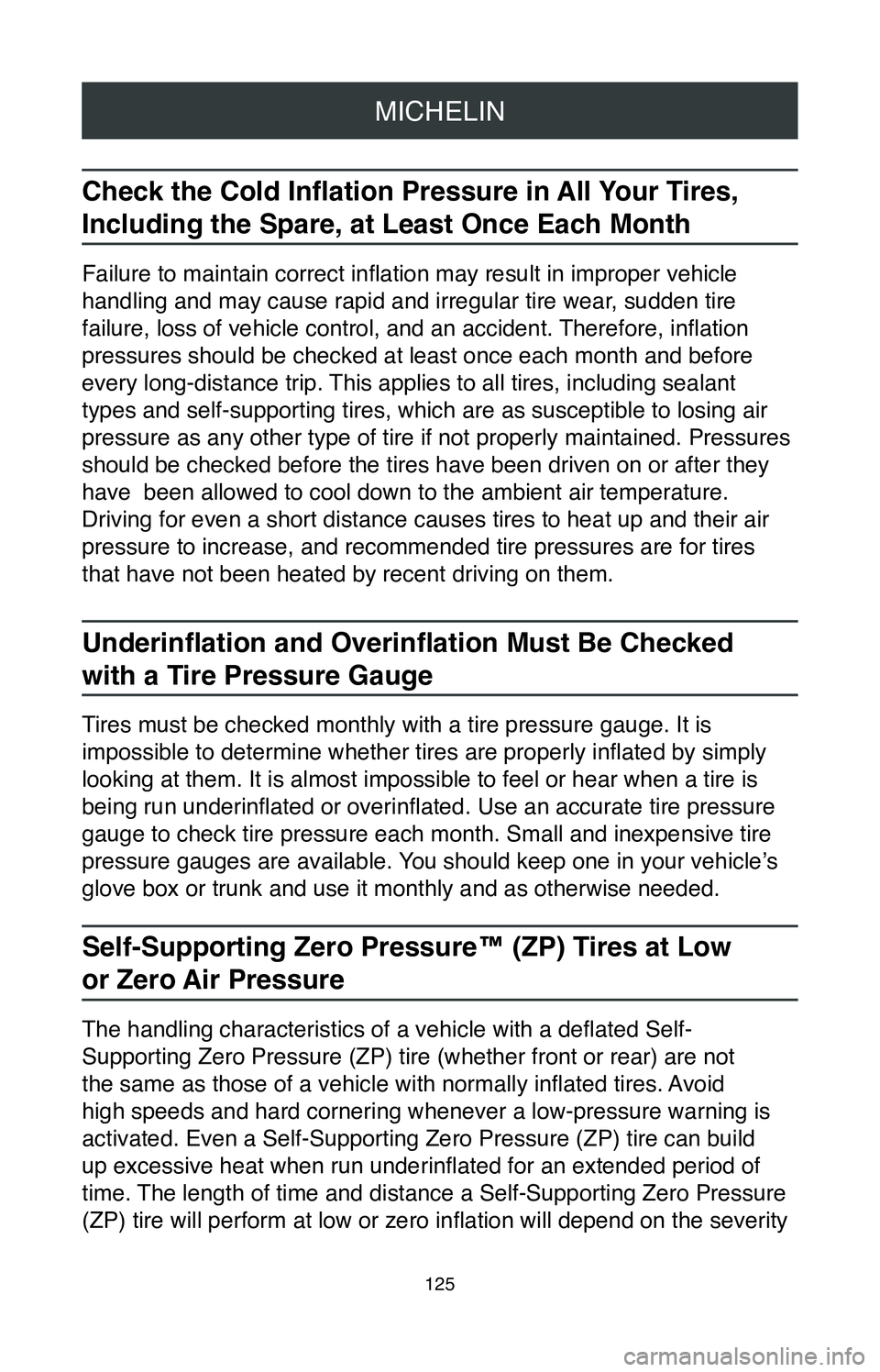
MICHELIN
125
Check the Cold Inflation Pressure in All Your Tires,
Including the Spare, at Least Once Each Month
Failure to maintain correct inflation may result in improper vehicle
handling and may cause rapid and irregular tire wear, sudden tire
failure, loss of vehicle control, and an accident. Therefore, inflation
pressures should be checked at least once each month and before
every long-distance trip. This applies to all tires, including sealant
types and self-supporting tires, which are as susceptible to losing air
pressure as any other type of tire if not properly maintained. Pressures\
should be checked before the tires have been driven on or after they
have been allowed to cool down to the ambient air temperature.
Driving for even a short distance causes tires to heat up and their air \
pressure to increase, and recommended tire pressures are for tires
that have not been heated by recent driving on them.
Underinflation and Overinflation Must Be Checked
with a Tire Pressure Gauge
Tires must be checked monthly with a tire pressure gauge. It is
impossible to determine whether tires are properly inflated by simply
looking at them. It is almost impossible to feel or hear when a tire is \
being run underinflated or overinflated. Use an accurate tire pressure
gauge to check tire pressure each month. Small and inexpensive tire
pressure gauges are available. You should keep one in your vehicle’s
glove box or trunk and use it monthly and as otherwise needed.
Self-Supporting Zero Pressure™ (ZP) Tires at Low
or Zero Air Pressure
The handling characteristics of a vehicle with a deflated Self-
Supporting Zero Pressure (ZP) tire (whether front or rear) are not
the same as those of a vehicle with normally inflated tires. Avoid
high speeds and hard cornering whenever a low-pressure warning is
activated. Even a Self-Supporting Zero Pressure (ZP) tire can build
up excessive heat when run underinflated for an extended period of
time. The length of time and distance a Self-Supporting Zero Pressure
(ZP) tire will perform at low or zero inflation will depend on the severity
Page 128 of 260
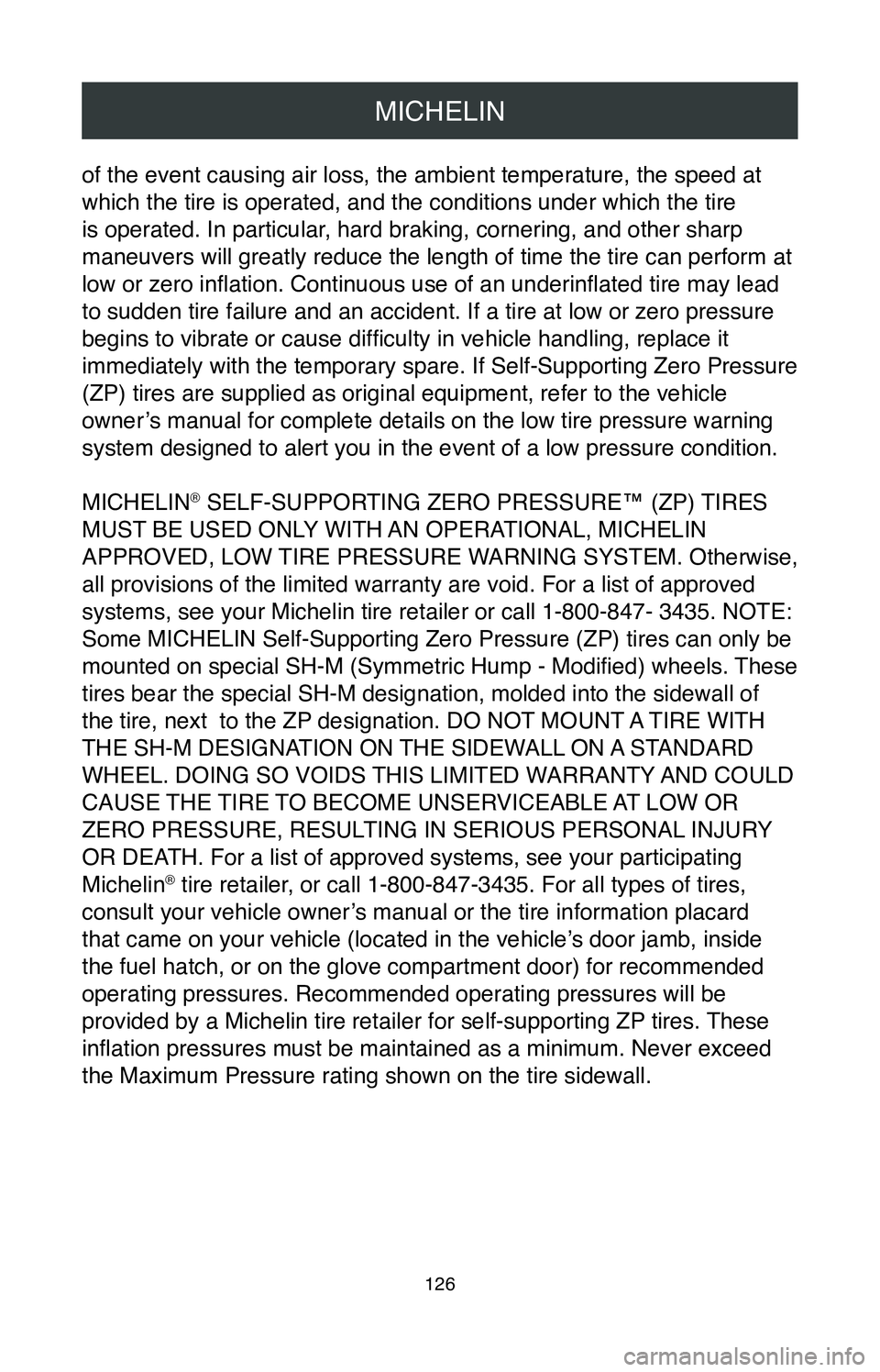
MICHELIN
126
of the event causing air loss, the ambient temperature, the speed at
which the tire is operated, and the conditions under which the tire
is operated. In particular, hard braking, cornering, and other sharp
maneuvers will greatly reduce the length of time the tire can perform at\
low or zero inflation. Continuous use of an underinflated tire may lead
to sudden tire failure and an accident. If a tire at low or zero pressur\
e
begins to vibrate or cause difficulty in vehicle handling, replace it
immediately with the temporary spare. If Self-Supporting Zero Pressure
(ZP) tires are supplied as original equipment, refer to the vehicle
owner’s manual for complete details on the low tire pressure warning
system designed to alert you in the event of a low pressure condition.
MICHELIN
® SELF-SUPPORTING ZERO PRESSURE™ (ZP) TIRES
MUST BE USED ONLY WITH AN OPERATIONAL, MICHELIN
APPROVED, LOW TIRE PRESSURE WARNING SYSTEM. Otherwise,
all provisions of the limited warranty are void. For a list of approved \
systems, see your Michelin tire retailer or call 1-800-847- 3435. NOTE:
Some MICHELIN Self-Supporting Zero Pressure (ZP) tires can only be
mounted on special SH-M (Symmetric Hump - Modified) wheels. These
tires bear the special SH-M designation, molded into the sidewall of
the tire, next to the ZP designation. DO NOT MOUNT A TIRE WITH
THE SH-M DESIGNATION ON THE SIDEWALL ON A STANDARD
WHEEL. DOING SO VOIDS THIS LIMITED WARRANTY AND COULD
CAUSE THE TIRE TO BECOME UNSERVICEABLE AT LOW OR
ZERO PRESSURE, RESULTING IN SERIOUS PERSONAL INJURY
OR DEATH. For a list of approved systems, see your participating
Michelin
® tire retailer, or call 1-800-847-3435. For all types of tires,
consult your vehicle owner’s manual or the tire information placard
that came on your vehicle (located in the vehicle’s door jamb, inside
the fuel hatch, or on the glove compartment door) for recommended
operating pressures. Recommended operating pressures will be
provided by a Michelin tire retailer for self-supporting ZP tires. These
inflation pressures must be maintained as a minimum. Never exceed
the Maximum Pressure rating shown on the tire sidewall.
Page 129 of 260
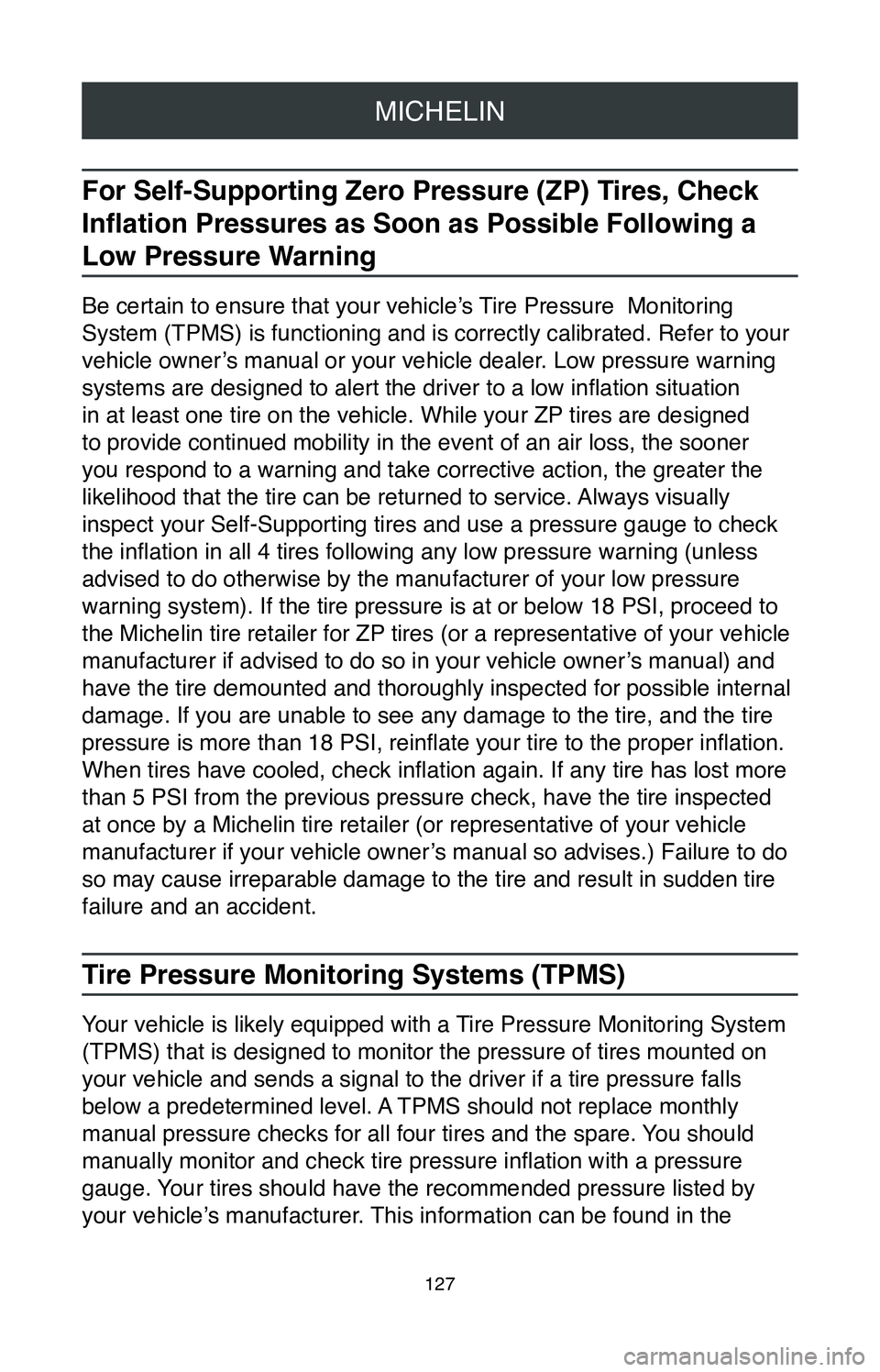
MICHELIN
127
For Self-Supporting Zero Pressure (ZP) Tires, Check
Inflation Pressures as Soon as Possible Following a
Low Pressure Warning
Be certain to ensure that your vehicle’s Tire Pressure Monitoring
System (TPMS) is functioning and is correctly calibrated. Refer to your
vehicle owner’s manual or your vehicle dealer. Low pressure warning
systems are designed to alert the driver to a low inflation situation
in at least one tire on the vehicle. While your ZP tires are designed
to provide continued mobility in the event of an air loss, the sooner
you respond to a warning and take corrective action, the greater the
likelihood that the tire can be returned to service. Always visually
inspect your Self-Supporting tires and use a pressure gauge to check
the inflation in all 4 tires following any low pressure warning (unless
advised to do otherwise by the manufacturer of your low pressure
warning system). If the tire pressure is at or below 18 PSI, proceed to\
the Michelin tire retailer for ZP tires (or a representative of your vehicle
manufacturer if advised to do so in your vehicle owner’s manual) and
have the tire demounted and thoroughly inspected for possible internal
damage. If you are unable to see any damage to the tire, and the tire
pressure is more than 18 PSI, reinflate your tire to the proper inflation.
When tires have cooled, check inflation again. If any tire has lost more
than 5 PSI from the previous pressure check, have the tire inspected
at once by a Michelin tire retailer (or representative of your vehicle
manufacturer if your vehicle owner’s manual so advises.) Failure to do
so may cause irreparable damage to the tire and result in sudden tire
failure and an accident.
Tire Pressure Monitoring Systems (TPMS)
Your vehicle is likely equipped with a Tire Pressure Monitoring System
(TPMS) that is designed to monitor the pressure of tires mounted on
your vehicle and sends a signal to the driver if a tire pressure falls
below a predetermined level. A TPMS should not replace monthly
manual pressure checks for all four tires and the spare. You should
manually monitor and check tire pressure inflation with a pressure
gauge. Your tires should have the recommended pressure listed by
your vehicle’s manufacturer. This information can be found in the
Page 130 of 260
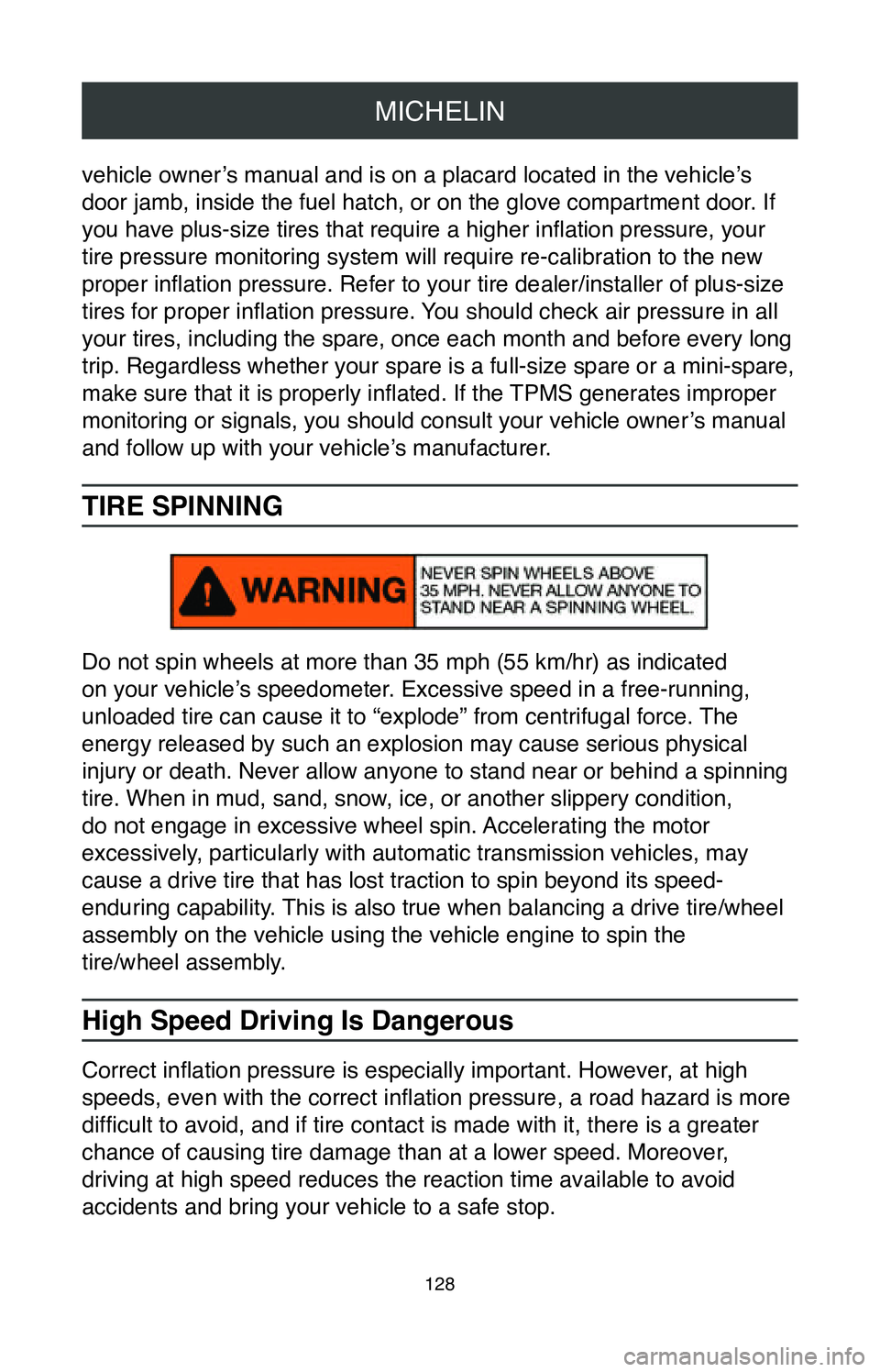
MICHELIN
128
vehicle owner’s manual and is on a placard located in the vehicle’s
door jamb, inside the fuel hatch, or on the glove compartment door. If
you have plus-size tires that require a higher inflation pressure, your
tire pressure monitoring system will require re-calibration to the new
proper inflation pressure. Refer to your tire dealer/installer of plus-size
tires for proper inflation pressure. You should check air pressure in all
your tires, including the spare, once each month and before every long
trip. Regardless whether your spare is a full-size spare or a mini-spare,
make sure that it is properly inflated. If the TPMS generates improper
monitoring or signals, you should consult your vehicle owner’s manual
and follow up with your vehicle’s manufacturer.
TIRE SPINNING
Do not spin wheels at more than 35 mph (55 km/hr) as indicated
on your vehicle’s speedometer. Excessive speed in a free-running,
unloaded tire can cause it to “explode” from centrifugal force. The
energy released by such an explosion may cause serious physical
injury or death. Never allow anyone to stand near or behind a spinning
tire. When in mud, sand, snow, ice, or another slippery condition,
do not engage in excessive wheel spin. Accelerating the motor
excessively, particularly with automatic transmission vehicles, may
cause a drive tire that has lost traction to spin beyond its speed-
enduring capability. This is also true when balancing a drive tire/wheel
assembly on the vehicle using the vehicle engine to spin the
tire/wheel assembly.
High Speed Driving Is Dangerous
Correct inflation pressure is especially important. However, at high
speeds, even with the correct inflation pressure, a road hazard is more
difficult to avoid, and if tire contact is made with it, there is a greater
chance of causing tire damage than at a lower speed. Moreover,
driving at high speed reduces the reaction time available to avoid
accidents and bring your vehicle to a safe stop.